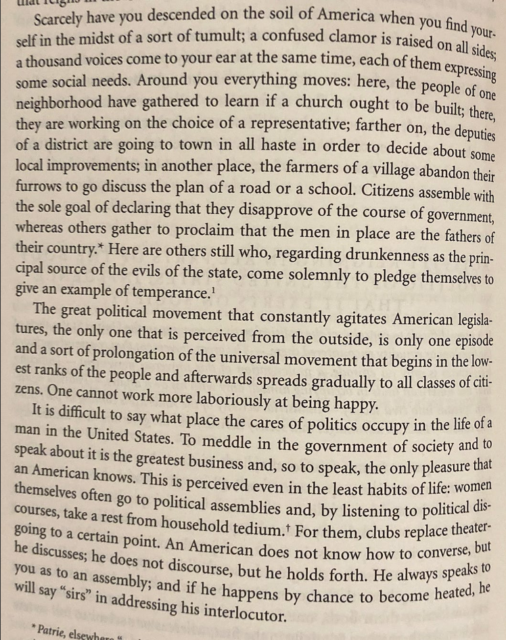Work outwards from this change and you will begin to have some idea of how much Britain has altered. The bits you don’t or can’t see are as unsettlingly different as those tattoos. Look up instead at the Houses of Parliament, all pinnacles, leaded windows, Gothic courtyards and cloisters, which look to the uninitiated as if they are a medieval survival. In fact they were completed in 1860, and are newer than the Capitol in Washington, D.C. The only genuinely ancient part — not used for any governing purpose — is the astonishing chilly space of Westminster Hall, faintly redolent of the horrible show trial of King Charles I, still an awkward moment in the national family album. But those who chose the faintly unhinged design wanted to make a point about the sort of country Britain then was, and they were very successful. Gothic meant monarchy, Christianity, and conservatism. Classical meant republican, pagan, and revolutionary, and mid-Victorian Britain was thoroughly wary of such things, so Gothic was chosen and the Roman Catholic genius Augustus Welby Pugin let loose upon the design. Wherever you are in the building, it is hard to escape the feeling of being either in a church, or in a country house just next to a church. The very chimes of the bell tower were based upon part of Handel’s great air from The Messiah: “I know that my Redeemer liveth”.
I worked for some years in this odd place. It is by law a Royal Palace, so nobody was ever officially allowed to die on the premises, in case the death had to be inquired into by some fearsome, forgotten tribunal, perhaps a branch of Star Chamber. Those who appeared to have deceased were deemed to be still alive and hurried to a nearby hospital where life could be pronounced extinct and an ordinary inquest held. We were also exempt from the alcohol laws that used in those days to keep most bars shut for a lot of the time, and if the drinks were not free they were certainly amazingly cheap.
In my years of wandering its corridors and lobbies, of hanging about for late-night votes and dozing in committee rooms, I came to loathe British politics and to mistrust the special regiment of journalists (far too close to their sources) who write about it. I had hoped for a kingdom of the mind and found a squalid pantry in which greasy, unprincipled deals were made by people who were no better than they ought to be.
But I came to love the building. Once you had got past the police sentinels, who knew who everyone was, you could go everywhere, even the thrilling ministerial corridor behind the Speaker’s chair, from which Prime Ministers emerged to face what was then the genuine ordeal of Parliamentary questions, twice a week. There was a rifle range beneath the House of Lords, set up during World War I to make sure honorable members of both Houses would be able to shoot Germans accurately if they ever met any. There was a room where they did nothing but prepare vast quantities of cut flowers, and which perfumed the flagstone corridor in which it lay. There was a convivial staff bar (known to few) where the beer was the best in the building and politicians in trouble would hide from their colleagues. The Lords had a whole half of the Palace, with lovely murals illustrating noble moments of our history, and the Chief Whip’s cosy, panelled office where reporters would be summoned once a week for dangerous gossip and perilously large glasses of whisky or very dry sherry, generously refilled. And high up in the roof, looking down over the murky Thames, was the room where the government briefed us, in meetings whose existence we were sworn never to reveal. Now they are pretty much public, so the real briefings must happen somewhere else, I suppose.
Peter Hitchens, “An Empty Parliament”, First Things, 2017-10-03.
December 11, 2023
QotD: The Palace of Westminster
December 10, 2023
“The peasants are revolting!”
Chris Bray says we’re back to aristocracy:
What do Americans think of vitriolic language directed at government?
Remember that Superior Court Judge William Fahey has just tentatively ruled, in a First Amendment lawsuit over the decision by the Los Angeles County Department of Public Health to forbid public comments on its social media posts, that the county has not engaged in viewpoint discrimination, because the public is yucky:
Comments were closed to the public because many were “extreme” and vitriolic; therefore, no First Amendment violation has occurred. Government cannot discriminate against your viewpoint if your viewpoint is extreme, or if it’s expressed too strongly; the First Amendment only protects inoffensive expression.
The lowest-hanging fruit for the counterargument is all in New York Times Company v. Sullivan, in which a quite liberal Supreme Court repeatedly and very clearly spelled out the American standard for the criticism of government. Justice Arthur Goldberg, in a concurring opinion: “In my view, the First and Fourteenth Amendments to the Constitution afford to the citizen and to the press an absolute, unconditional privilege to criticize official conduct despite the harm which may flow from excesses and abuses”.
This is how the Supreme Court showed up in 1964 to start thinking about a case involving the limits of speech about public officials; as Justice William Brennan, Jr. wrote in the majority opinion, “we consider this case against the background of a profound national commitment to the principle that debate on public issues should be uninhibited, robust, and wide-open, and that it may well include vehement, caustic, and sometimes unpleasantly sharp attacks on government and public officials.”
Compare that conclusion to the argument that government has not engaged in viewpoint discrimination, because it banned comments only in the context of being addressed with vitriol. We didn’t say we didn’t didn’t like their viewpoint; we just said that their opinions were too extreme.
But here’s the important thing about New York Times Company v. Sullivan: it’s a history lesson. The majority opinion quotes James Madison and John Stuart Mill, and examines debates over public speech in the early republic. Looking at the national past and its political sources, they saw only the idea that government officials may properly be addressed with whatever degree of firmness citizens choose to apply. American politics were never polite, and were never thought to be. The tumult of a democratic republic, Tocqueville wrote, “begins in the lowest ranks of the people”, storming the seats of government to shout their disapproval:
“… if he happens by chance to become heated”. That wasn’t pathology or exception; a French observer touring America thought that heated denunciations of government were signs of … a weekday. A scholar of early American politics has written colorfully about the way national officials limited the aggressiveness of attacks on their character: they shot each other, or threatened to.
Can the Americans Stop the Kamikazes? – WW2 – Week 276 – December 9, 1944
World War Two
Published 9 Dec 2023This is a very busy week of the war. In the west, the Americans manage to reach the Roer River in force, but haven’t taken any of its dams; in Italy, the Allies liberate Ravenna; the Soviet advance in Hungary continues, and the Soviets even set up a new Hungarian government; martial law is declared in Greece; the Japanese make a corridor to Indochina; the fighting on Leyte continues, and the kamikaze menace becomes ever more worrisome.
00:00 INTRO
01:10 British intelligence failure
01:55 Allies reach the Roer River
05:35 Problems with Devers’ 6th Army Group
07:41 Allies liberate Ravenna
08:50 Soviet advances in Hungary
12:10 Soviets set up a new Hungarian government
13:47 A deadly demonstration and martial law in Greece
18:33 Japanese establish a corridor to Indochina
19:59 Leyte and kamikaze attacks
23:45 CONCLUSION
(more…)
The history of the steam engine … but interactive
In the latest Age of Invention newsletter, Anton Howes is pleased to announce the release of a new ongoing project to illustrate the steam engine in an interactive format:
I’m excited to announce something I’ve been quietly working on for a few months now behind the scenes. Some of you may be familiar with the explorable interactive articles of Bartosz Ciechanowski. They are so clearly written and so cleverly explorable, that they give an intuitive grasp of how many very complicated technologies work. My favourite is his article on mechanical watches. Be warned: if you’ve not seen these before, you’re about to lose a good few hours.
But his article on watches — which came out just as I was doing some research on the development of watches, and which proved an invaluable reference work — got me thinking about how great it would be to have something similar not just for how current technologies function, but to show how they changed over time. Wouldn’t it be great, I dreamed, to have a similarly intuitive way to explore and appreciate the process of improvement. And to correct lots of misapprehensions about the development of various technologies along the way.
As it turned out, my fellow inventions history fanatic Jason Crawford, who runs the non-profit The Roots of Progress, had been thinking along the same lines. (Drumroll starts softly.) So with the help of the Matt Brown we’ve been able to realise what is hopefully just the first small step of our vision. (Drumroll intensifies.) Based on my recent work re-writing the standard pre-history of the steam engine (drumroll crescendoes), allow me to present:
(Cue trumpets!)
The interactive, animated, **Origins of the Steam Engine**
Alongside contemporary illustrations of the many devices, you can play around with the animated models, dragging them to see them from different angles. It introduces what are so far the only interactive and animated models yet made of a great many devices — from Philo of Byzantium’s 3rd Century BC experiments, to Salomon de Caus’s 1610s solar-activated and self-replenishing fountains and musical instruments, and the 1606 steam engine of the Spanish engineer Jerónimo de Ayanz y Beaumont:
It also contains the first depictions of the 1630s and 40s devices of Kaspar Kalthoff and William Petty. These are the experiments I discovered about a year ago, which I hope will now be given a place in the canon of the history of the steam engine. (You can read my discussion of the evidence I’d stumbled across about them here.)
Engines of War: How Wars Were Won and Lost on the Railways
WW2TV
Published 15 Jun 2023Engines of War: How Wars Were Won and Lost on the Railways With Christian Wolmar
Before the nineteenth century, armies had to rely on slow and unreliable methods of transportation to move soldiers and equipment during times of conflict. But with the birth of the railroad in the early 1830s, the way wars were fought would change forever. In this show renowned expert Christian Wolmar tells the story of that transformation with a focus on railways in WWII and especially the Normandy campaign.
Christian Wolmar is a British journalist, author, railway historian and Labour Party politician. He is known for his commentary on transport, especially as a pundit on Britain’s railway industry, and was named Transport Journalist of the Year in the National Transport Awards in 2007.
(more…)
QotD: Roman citizenship
As with other ancient self-governing citizen bodies, the populus Romanus (the Roman people – an idea that was defined by citizenship) restricted political participation to adult citizen males (actual office holding was further restricted to adult citizen males with military experience, Plb. 6.19.1-3). And we should note at the outset that citizenship was stratified both by legal status and also by wealth; the Roman Republic openly and actively counted the votes of the wealthy more heavily than those of the poor, for instance. So let us avoid the misimpression that Rome was an egalitarian society; it was not.
The most common way to become a Roman citizen was by birth, though the Roman law on this question is more complex and centers on the Roman legal concept of conubium – the right to marry and produce legally recognized heirs under Roman law. Conubium wasn’t a right held by an individual, but a status between two individuals (though Roman citizens could always marry other Roman citizens). In the event that a marriage was lawfully contracted, the children followed the legal status of their father; if no lawfully contracted marriage existed, the child followed the status of their mother (with some quirks; Ulpian, Reg. 5.2; Gaius, Inst. 1.56-7 – on the quirks and applicability in the Republic and conubium in general, see S.T. Roselaar, “The Concept of Conubium in the Roman Republic” in New Frontiers: Law and Society in the Roman World, ed. P.J. du Plessis (2013)).
Consequently the children of a Roman citizen male in a legal marriage would be Roman citizens and the children of a Roman citizen female out of wedlock would (in most cases; again, there are some quirks) be Roman citizens. Since the most common way for the parentage of a child to be certain is for the child to be born in a legal marriage and the vast majority of legal marriages are going to involve a citizen male husband, the practical result of that system is something very close to, but not quite exactly the same as, a “one parent” rule (in contrast to Athens’ two-parent rule). Notably, the bastard children of Roman women inherited their mother’s citizenship (though in some cases, it would be necessarily, legally, to conceal the status of the father for this to happen, see Roselaar, op. cit., and also B. Rawson, “Spruii and the Roman View of Illegitimacy” in Antichthon 23 (1989)), where in Athens, such a child would have been born a nothos and thus a metic – resident non-citizen foreigner.
The Romans might extend the right of conubium with Roman citizens to friendly non-citizen populations; Roselaar (op. cit.) argues this wasn’t a blanket right, but rather made on a community-by-community basis, but on a fairly large scale – e.g. extended to all of the Campanians in 188 B.C. Importantly, Roman colonial settlements in Italy seem to pretty much have always had this right, making it possible for those families to marry back into the citizen body, even in cases where setting up their own community had caused them to lose all or part of their Roman citizenship (in exchange for citizenship in the new community).
The other long-standing way to become a Roman citizen was to be enslaved by one and then freed. An enslaved person held by a Roman citizen who was then freed (or manumitted) became a libertus (or liberta), by custom immediately the client of their former owner (this would be made into law during the empire) and by law a Roman citizen, although their status as a freed person barred them from public office. Since they were Roman citizens (albeit with some legal disability), their children – assuming a validly contracted marriage – would be full free-born Roman citizens, with no legal disability. And, since freedmen and freedwomen were citizens, they also could contract valid marriages with other Roman citizens, including freeborn ones […]. While most enslaved people in the Roman world had little to no hope of ever being manumitted (enslaved workers, for instance, on large estates far from their owners), Roman economic and social customs functionally required a significant number of freed persons and so a meaningful number of new Roman citizens were always being minted in the background this way. Rome’s apparent liberality with admission into citizenship seems to have been a real curiosity to the Greek world.
These processes thus churned in the background, minting new Romans on the edges of the populus Romanus who subsequently became full members of the Roman community and thus shared fully in the Roman legal identity.
Bret Devereaux, “Collections: The Queen’s Latin or Who Were the Romans, Part II: Citizens and Allies”, A Collection of Unmitigated Pedantry, 2021-06-25.
December 9, 2023
The coming Micro-Macro culture war … and who’s going to win it
Ted Gioia outlines the dismal state of the “macro” culture — television, movies, newspapers, book publishing and all the big corporations that control them — with the dynamism of the “micro” culture:
In the beginning, all culture was microculture.
You knew what was happening in your tribe or village. But your knowledge of the wider world was limited.
So you had your own songs and your own stories. You had your own rituals and traditions. You even had your own language.
But all these familiar things disappeared when you went off into the world. That was dangerous, however. That’s why only heroes, in traditional stories, go on journeys.
You learn on the journey. But you might not survive.
But all that changed long before I was born.
In my childhood, everything was controlled by a monoculture. There were only three national TV networks, but they were pretty much the same.
When I went to the office, back then, we had all watched the same thing on TV the night before. We had all seen the same movie the previous weekend. We had all heard the same song on the radio while driving to work.
The TV shows were so similar that they sometimes moved from CBS to NBC, and you never noticed a change. The newscasters also looked pretty much the same and always talked the same — with that flat Midwestern accent that broadcasters always adopted in the US.
The same monoculture controlled every other creative idiom. Six major studios dominated the film business. And just as Hollywood controlled movies, New York set the rules in publishing. Everything from Broadway musicals to comic books was similarly concentrated and centralized.
The newspaper business was still local, but most cities had 2 or 3 daily newspapers — and much of the coverage they offered was interchangeable. Radio was a little more freewheeling, but eventually deregulation allowed huge corporations to acquire and standardize what happened over the airwaves. [NR: I suspect the “freewheeling” went away once the government started imposing regulations, and the corporate consolidation was enabled when they “deregulated” the radio licensing regime several decades later.]
When I went to work in an office, back then, we had all watched the same thing on TV the night before. We had all seen the same movie the previous weekend. We had all heard the same song on the radio while driving to work.
And that’s why smart people back then paid attention to the counterculture.
The counterculture might be crazy or foolish or even boring. But it was still your only chance to break out of the monolithic macroculture.
Many of the art films I saw at the indie cinema were awful. But I still kept coming back — because I needed the fresh air these oddball movies provided. For the same reason, I read the alt weekly newspapers and kept tabs on alt music.
In fact, whenever I saw the word alt, I paid attention.
That doesn’t mean that I hated the major TV networks, or the large daily newspaper, or 20th Century Fox. But I craved access to creative and investigative work that hadn’t been approved by people in suits working for large organizations.
The Internet should have changed all this. And it did — but not much. Even now the collapse in the monoculture is still in its early stages.
But that’s about to change.
If you don’t pay close attention, the media landscape seems pretty much the same now as it did in the 1990s. The movie business is still controlled in Hollywood. The publishing business is still controlled in New York. The radio stations are still controlled by a few large companies. And instead of three national TV networks plus PBS, we have four dominant streaming platforms — who control almost 70% of the market.
So we still live in a macro culture. But it feels increasingly claustrophobic. Or even worse, it feels dead.
Meanwhile, a handful of Silicon Valley platforms (Google, Facebook, etc.) have become more powerful than the New York Times or Hollywood studios or even Netflix. It’s not even close — the market capitalization of Google’s parent Alphabet is now almost ten times larger than Disney’s.
But here’s the key point — these huge tech companies rely on the microculture for their dominance.
Where is Facebook without users contributing photos, text and video? Where is Google’s YouTube without individual creators?
In terms of economic growth or audience capture, the microculture has already won the war. But it doesn’t feel that way.
Why not?
First and foremost, Silicon Valley is a reluctant home for the microculture. To some extent Alphabet and Facebook are even going to war with microculture creators — they try to make money with them even while they punish them.
- So Mark Zuckerberg needs creators, but won’t even let them put a live link on Instagram and limits their visibility on Facebook and Threads.
- Alphabet needs creators to keep YouTube thriving, but gives better search engine visibility to total garbage that pays for placement.
- Twitter also claims it wants to support independent journalists — but if you’re truly independent from Elon Musk, your links are brutally punished by the algorithm.
This tension won’t go away, and next year it will get worse. The microculture will increasingly find itself at war with the same platforms they rely on today.
And legacy media and non-profits are even more hostile to emerging media. Go see who wins Pulitzer Prizes, and count how many journalists on alternative platforms get honored.
I’ll save you the trouble. They don’t.
All those (officially unexplained) “excess” mortalities
Mark Steyn discusses European and Antipodean statistical reports that echo what Maxime Bernier was talking about the other day on the as-yet officially unexplained huge rise in “excess mortality” since the Wuhan Coronavirus pandemic:
We are now three years into the administration of the Covid vaccines, and we have many startling statistical anomalies, including the most basic one of all: a huge mound of extra corpses. Per the EU’s official statistics agency:
Among the eighteen EU Member States that recorded excess deaths, the highest rates were in Cyprus (13.9%), Finland (13.4%), the Netherlands (12.7%) and Ireland (12.5%).
Those percentages are sufficiently high that in the Netherlands, formerly one of the healthiest nations on earth, they’re reducing life expectancy. The ongoing excess deaths are at odds with the normal post-pandemic pattern, such as the Spanish Flu a century ago. The intro to this new scientific paper sets out what’s meant to be happening:
Our approach takes into account age and gender, but also under-mortality that you would expect after a period of excess mortality.
“Under-mortality” occurs because, if the Spanish Flu killed you prematurely in 1920, you weren’t around to die when you otherwise would have done in 1924. Hence, excess mortality is followed by under-mortality. So:
If this under-mortality does not seem to be happening, it is actually hidden excess mortality.
That’s an important point. What Eurostat identifies as an excess mortality rate in Ireland of 12.5 per cent is, as a practical matter, actually higher – because it should be measured against not the pre-Covid baseline but the under-mortality one would have expected four years on. So persistent excess mortality is deeply weird, and, unlike those killed by the virus (where the median age of death by Covid is above most developed nations’ life expectancy), the extra deaths, as we have discussed on The Mark Steyn Show, are skewed towards the young and middle-aged:
We note that excess mortality in the Netherlands remains consistently high during 2020-2022 and has shifted from high to low age and towards men.
In other words, it’s not a general trend of excess deaths, but something more particular. Which, in a normal environment, would suggest something particular is causing it. Aside from excess deaths in “low age”, we also have excess deaths at no age – the babies who aren’t being born. The western world’s jabbed and re-jabbed citizenry has seen a catastrophic slump in newborns. Scandinavia:
The whole region reported sharp declines in fertility rates in 2022. Finland had the lowest fertility rate of all Nordic countries, 1.32 children. This is also the lowest Finnish rate since 1776 when monitoring of fertility rates first started.
Incidentally, that Finnish rate – of 1.3 children per woman – is what demographers call “lowest-low fertility”, from which no society has ever recovered.
Fortunately for officialdom, there was enough Covid circulating in Finland, Ireland, the Netherlands, etc that the ever higher mountain of corpses can be shrugged off as most likely “Long Covid” or maybe, if necessary, “Extra-Long Covid”. In the Antipodes, they can’t get away with that. Australia and New Zealand enacted some of the most draconian public-health measures on the planet, and in effect quarantined their entire nations. As a result, pre-Omicron they had all but negligible accounts of Covid. But they obediently submitted themselves to the mass vaccination regime. And, whaddaya know, they too have extraordinary rates of excess death.
Clare Craig, a favourite guest of The Mark Steyn Show, has published a detailed analysis of the post-vaccination years Down Under. It makes for sober reading.
In 2021, for example, they had officially 1,224 deaths from Covid.
But also in 2021 – the first full year of the vaccines – they had 876 excess deaths from ischaemic heart disease alone. Plus another 583 excess deaths from other cardiac diseases.
Death by ischaemic heart disease had been in decline in Australia in the pre-vaccine years, but, having shot up in 2021, it went up even further in 2022. (Same trend with strokes.) So, having shut down the country for those 1,224 Covid deaths, you would think the public health bureaucracy might show a smidgeonette of interest in those 1,359 excess cardiac deaths.
But apparently not.
Now, across the Tasman Sea, we have a Kiwi whistleblower, Barry Young, who has released an avalanche of data with some quite disturbing takeaways that I referenced on Wednesday’s Clubland Q&A. I was careful to qualify my remarks with a lot of “ifs”, but our friend Norman Fenton, Professor of Risk Information Management at Queen Mary University, has taken a look and The Conservative Woman has published his findings. I see that on the Internet the kneejerk reaction was that Mr Young had simply leaked a lot of vaccination stuff from the old folks’ homes where the Covid centenarians would have died anyway. So it’s a biased sample.
In reality, it does not appear to be a “sample” at all:
[Steve Kirsch] says that there are widespread misunderstandings about the data and it is not biased. For a start he says that the dataset is the complete set of ‘pay-per-dose’ vaccination records and therefore there is no biased sampling at all. He says:
“The people within the group is representative of the total population. There are 2.2 million people in the group, and there are 4 million records. Each of those records is a Vaccination Record.”
2.2 million is over forty per cent of the population of New Zealand. That’s some “sample”. Nevertheless, Professor Fenton is being scrupulously cautious:
Even accounting for inevitable “survivor bias” (the more jabs a person gets, the quicker they are likely to die after their last jab) there was some evidence of increased risk the more doses a person gets. Moreover, given Steve’s comments about the datatset being the complete set of “pay-per-dose” vaccination records, this conclusion seems robust even if there were a biased proportion of vaccinee deaths in the dataset. Also (as per my above quote in Steve’s presentation) I felt that the data provided further support for the hypothesis that the vaccine was increasing the mortality rate in the older population (something which we had already concluded based on the most recent ONS data).
It’s interesting that such questions never come up at Britain’s official “Covid inquiry” which is increasingly risible in its palpable determination to find that the only mistake that was made was not to lock down harder and faster.
The other takeaway mentioned by Professor Fenton is the fatality rate of individual batches. Take a look at this handy graph:
I suppose it would be possible to argue that all 711 jabs of Batch #1 were administered to residents of the Shady Acres Retirement Home for Centenarians with Stage Four Ebola. But it’s difficult to make the same case with Batch #62 which went into the arms of 18,173 New Zealanders and killed 831 of them. Which, all by itself, is two hundred times the country’s official death toll from the vaccines. Which is to say, according to His Majesty’s Government in Wellington, precisely four Kiwis are dead of the vax.
Romanian ZB-30 LMG: Improving the Already-Excellent ZB-26
Forgotten Weapons
Published 30 Aug 2023Brno’s ZB-26 was one of the best light machine guns of the 1920s, and it was widely adopted by countries that did not have domestic arms design and production capacity (and it would eventually become the British Bren gun as well). It was designed for the 8mm Mauser cartridge, and had a simple fixed gas system that ran very well — until countries began following the German lead in moving to standard use of s.S. (schweres Spitzgeschoß; heavy ball) ammunition. This put undue strain on the ZB-26 mechanism, and so an improvement was made to include an adjustable gas system that could be set to accommodate a variety of loadings. This experimental model was the ZB-27, and it was tested by Romania in the late 1920s.
Romania liked the design, and adopted it in 1930, purchasing guns from Brno and also buying a license to produce them at the Cugir factory complex in Romania. Today we are taking a look at two examples of Romanian ZB-30s, one Czech-made and one Romanian-made. They both incorporate a number of improvements over the ZB-26 (improved barrel latch security, rear monopod socket, bipod locking lever, etc) but also have a few minor differences from each other.
Thanks to the Southern Iceland Shooting Association for helping me film these and other cool guns in Iceland!
(more…)
QotD: A secret of effective writing
I’m in the process of editing a document for a technical project that is intended to be an introduction for newbies to certain fairly complex issues. While requesting feedback on the project mailing list, I realized that I had accidentally revealed a major secret of really top-grade writing, exactly the sort of thing that put The Cathedral and the Bazaar on the New York Times best-seller list.
I see no reason not to share it with my readers. So here is the relevant part of my request for feedback:
Please fix typos and outright grammatical errors. If you think you have spotted a higher-level usage problem or awkwardness, check with me before changing it. What you think is technically erroneous may be expressive voice.
Explanation: Style is the contrast between expectation and surprise. Poets writing metric poetry learn to introduce small breaks in scansion in order to induce tension-and-release cycles at a higher level that will hold the reader’s interest. The corresponding prose trick is to bend usage rules or change the register of the writing slightly away from what the reader unconsciously expects. If you try to “fix” these you will probably be stepping on an intended effect. So check first.
(I will also observe that unless you are already an unusually skilled writer, you should not try to replicate this technique; the risk of sounding affected or just teeth-jarringly bad is high. As Penn & Teller puts it, “These stunts are being performed by trained, professional idiots.”)
Eric S. Raymond, “A major secret of effective writing”, Armed and Dangerous, 2011-02-05.
December 8, 2023
“An error of this magnitude makes one wonder how robust such calculations are”
Christopher Snowden notes the proliferation of media and public advocacy groups warning us about “junk food”:
On Monday, the front page of The Times led with a speech from Henry Dimbleby and a cost-of-obesity estimate from the Tony Blair Institute for Global Change — the perfect start to the week for any Times reader. According to Sir Tony’s think tank, “the effect on national productivity from excess weight is nine times bigger than previously thought”. An error of this magnitude makes one wonder how robust such calculations are (the previous estimate only came out last year), but Mr Dimbleby saw it as further proof that food should be treated like smoking.
The NHS “will suck all the money out of the other public services” while “at the same time, economic growth and tax revenue will stagnate. We will end up both a sick and impoverished nation,” Dimbleby will warn.
Would it be unfair to point out that the USA has much higher rates of obesity than the UK and also has much higher GDP growth?
As I pointed out on what I shall continue to call Twitter, the estimates as bunkum. They come from Frontier Economics and were first commissioned by the makers of Wegovy, presumably to make their effective but expensive weight loss drug look like a relative bargain.
Their previous estimate of the cost of obesity to “society” was £58bn. This year’s estimate is £98bn, most of which (£57bn) comes from lost quality-adjusted life years. As I tire of pointing out, these are internal costs to the individual which, by definition, are not costs to wider society. I can’t stress enough how absurd it is to include lost productivity due to early death as a cost to the economy. You might as well calculate the lost productivity of people who have never been born and claim that contraception costs the economy billions of pounds.
Since the previous estimate, the costs have been bulked up by including the costs of being overweight, but there is no indication in the wafer-thin webpage of what these are. Being merely overweight doesn’t have many serious health implications. The healthcare costs have doubled, but as in the previous report, the new estimate does not look at how much more healthcare would be consumed if there was no obesity. No savings are included. What we need is the net cost.
The “report” that The Times turned into a front page news story is no more than a glorified blog post. It contains no detail, no methodology and none of the assumptions upon which it is based can be checked. It comes with an eight page slideshow from Frontier Economics which is described as a “full analysis” but which doesn’t contain any useful figures either.
Estimates like this are bound to mislead the casual reader into thinking that they are paying higher taxes because of obesity. There is no other reason to publish them, as they have no academic merit. They are designed to be misunderstood.
Sure enough, the very next day The Times was explicitly claiming that the putative £98 billion — now rounded up to £100 billion — was a direct cost to government …
The findings come after an analysis found this week that Britain’s weight problem is costing the state almost £100 billion a year.
The development of the American suburb
In the latest book review from Mr. and Mrs. Psmith’s Bookshelf, Jane Psmith discusses A Field Guide to American Houses (Revised): The Definitive Guide to Identifying and Understanding America’s Domestic Architecture, by Virginia Savage McAlester. In particular, she looks at McAlester’s coverage of how suburbs developed:
After some brief but interesting discussion of cities,1 most of the page count is devoted to the suburbs. It’s a sensible choice: suburbs have by far the most varied types of house groupings, and more than half of Americans live in one. But what exactly is a “suburb”? It’s a wildly imprecise word, referring to anything that is neither truly rural nor the central urban core, and suburbs vary tremendously in character. As a working definition, though, a suburb is marked by free-standing houses on relatively larger lots. (If you can think of a counter-example that qualifies but is “urban”, I’ll bet you $5 it started out as a suburb before the city ate it.)
This means that building a suburb has a few obvious technological prerequisites, which McAlester lists as follows: First, balloon-frame construction, which enabled not just corners but quick and inexpensive construction generally and removed much of the incentive for the shared walls that were so common in the early cityscape. Second, the proliferation of gas and electric utilities in the late nineteenth century meant that the less energy-efficient free-standing homes could still be heated relatively inexpensively. Third, the spread of telephone service after 1880 meant that it was much easier to stay in touch with friends whose front doors weren’t literally ten feet away from yours.2 But by far the most important technological advances came in the field of transportation, which is obviously necessary if you’re going to live in the country (or a reasonable facsimile thereof) and work in the city.
The first of these transportation advances was the railroad. In fact “railroad suburb” is a bit of a misnomer, because most of the collections of houses that grew up around the new rail stops were fully functional towns that had their own agricultural or manufacturing industries. The most famous railroad suburbs, however, were indeed planned as residential communities serving those wealthy enough to pay the steep daily rail fare into the city. Llewellyn Park near New York City, Riverside near Chicago, and the Main Line near Philadelphia are all examples of railroad suburbs that have maintained their tony atmosphere and high property values.
The next and more dramatic change was the advent of the electric trolley or streetcar, first introduced in 1887 but popular until about 1930. (That’s what all the books say, but come on, it’s probably October 1929, right?) Unlike steam locomotives, which take quite a long time to build up speed or to slow down again, and so usually had their stations placed at least a mile apart, streetcars could start and stop far more easily and feature many more, and more densely-placed, stops. Developers typically built a streetcar line from the city veering off into the thinly-inhabited countryside, ending at an attraction like a park or fairground if possible. If they were smart, they’d bought up the land along the streetcar beforehand and could sell it off for houses,3 but either way the new streetcar line added value to the land and the development of the land made the streetcar more valuable.
You can easily spot railroad towns and streetcar suburbs in any real estate app if you filter by the date of construction (for railroad suburbs try before 1910, for streetcar before 1930) and know what shapes to look for. Railroad towns are typically farther out from the urban center and are built in clusters around their stations, which are a few miles from one another. Streetcar suburbs, by contrast, tend to be continuous but narrow, because the appeal of the location dropped off rapidly with distance from the streetcar line. (Lots are narrow for the same reason — to shorten the pedestrian commute.) They expand from the urban center like the spokes of a wheel.
And then came the automobile and, later, the federal government. The car brought a number of changes — paved streets, longer blocks, wider lots (you weren’t walking home, after all, so it was all right if you had to go a little farther) — but nothing like the way the Federal Housing Authority restructured neighborhoods.
The FHA was created by the National Housing Act of 1934 with the broad mandate to “improve nationwide housing standard, provide employment and stimulate industry, improve conditions with respect to mortgage financing, and realize a greater degree of stability in residential construction”. It was a big job, and the FHA set out to accomplish it in a typical New Deal fashion: providing federal insurance for private construction and mortgage loans, but only for houses and neighborhoods that met its approval. This has entered general consciousness as “redlining”, after the color of the lines drawn around uninsurable areas (typically old, urban housing stock),4 but the green, blue, and yellow lines — in order of declining insurability — were just as influential on the fabric of contemporary America.
A slow economy through the 1930s and a prohibition on nonessential construction during the war meant that FHA didn’t have much to do until 1945, but as soon as the GIs began to come home and take advantage of their new mortgage subsidies, there was a massive construction boom. With the FHA insuring both the builders’ construction loans and the homeowners’ mortgages, nearly all the new neighborhoods were built to the FHA’s exacting specifications.
One of the FHA’s major concern was avoiding direct through-traffic in neighborhoods. Many post-World War II developments were built out near the new federally-subsidized highways on the outskirts of the cities, so the FHA was eager to protect new subdivisions from heavy traffic on the interstates and the major arterial roads. Neighborhoods were meant to be near the arterials, but with only a few entrances to the neighborhood and many curved roads and culs-de-sac within it. Unlike the streetcar suburbs or the early automobile suburbs that filled in between the “spokes” of the streetcar lines, where retail had clustered near the streetcar stops, the residents of the post-World War II suburbs found their closest retail establishments outside the neighborhood on the major arterial roads. Lots became wider, blocks longer, and sidewalks less frequent; houses were encouraged to stay small by FHA caps on the size of loans. And although we tend to assume they were purely residential areas, the FHA encouraged the inclusion of schools, churches, parks, libraries, and community centers within the neighborhood.
1. America doesn’t have many urban neighborhoods that predate 1750, and even fewer that persist in their original layout, but if you’ve ever visited one it’s amazing how compact everything feels even in comparison to the rowhouses of the following century.
2. McAlester’s footnote for the paragraph that contains all this reads: “These three essentials were highlighted in an essay the author has read but has not been successful in locating for this footnote.”
3. This is still, I am told, how some of the more sensibly-governed parts of the world run their transit systems: whatever company has the right to build subways buys up the land around a planned (but not announced) subway line through shell corporations, builds the subway, then sells or develops the newly-valuable property. Far more efficient as a funding mechanism than fares!
4. This 2020 NBER working paper points out that redlined areas were 85% white (though they did include many of the black people living in Northern cities) and suggests that race played very little role in where the red lines were drawn; rather, black people were already living in the worst neighborhoods.
“When you see the same signs here that characterised collapse in other polities for the last 5000 years, it means collapse is coming here too – we’re not special snowflakes”
Feeling good? Happy with your culture and comfortable that major disruptions won’t disturb you? Here’s Theophilus Chilton to harsh your mellow:
There are essentially three basic reasons why those on the American Right haven’t shrugged the same way regular folks in Europe are beginning to (see Spain and France as well as Ireland for recent examples). The first of these is because the American Right still holds onto a residual trust in elections and democracy and the whole “We’ll get ‘em next election!” mentality. Having been fed a decades-long diet of reverence for democracy and voting and whatnot acts as a desensitising agent that keeps many Americans anesthetised to the actual uselessness of such attitudes.
But this will continue to erode as we see more obvious election fraud. Eventually, when the norm becomes “go to bed with the right-wing candidate ahead by 10% and wake up with the left-wing candidate winning by 0.5%,” elections will lose what legitimacy they have left. Further, as “democracy” comes to be increasingly defined as “whatever the Regime wants to do“, more and more normies will start to clue in to the fact that democratic forms are not going to save America, but are in fact what are destroying it.
Second, Heritage Americans and those on the normie Right tend to assume that everybody still plays by the old, traditional set of norms, including FedGov. This “seemed” plausible when the Regime employed incrementalism to gradually acculturate normies to its agenda. But as they accelerate their revolutionary overthrow of everything that normies thought would be sacrosanct like they have over the past few years, this sense of “norms” will go away. And when that happens, there will be a whole lot of people suddenly open to the possibility that something else might become a new set of norms.
Third, because America is so BIG – especially in the geographical sense – Heritage Americans have been able to self-mitigate many of the worse aspects of the Regime agenda. They could get away from the slums. Federalism allowed them to find states in which to prosper despite the Regime’s efforts. And so forth. Regular folks in many places could still plausibly think America was a high trust, high social cohesion society because where they were at locally might well have been. But as the Regime accelerates, this also will stop. $oros DAs will continue to release violent criminals while punishing law-abiding citizens for defending themselves and their property. Immigration and inflation will further erode the economic prosperity that still remains, which is something that fleeing to a Red state can’t fix. And of course, it will all be brought home starkly once 20,000 or so Palestinian “refugees” get relocated into their counties.
Let’s remember that this is what we actually saw in Ireland. Even into the Oughts, Ireland was homogenous, relatively high IQ and high trust, was the Celtic Tiger with lots of prosperity. Then globohomo decided that Ireland needed tons of “refugees” just like the rest of Europe and suddenly that prosperity and safety and high trust went away. What was the response? Riots and continued disorder that Regime attempts to clamp down on are only going to make worse.
This is going to wear out eventually, which is something that FedGov knows. That’s why they’ve been ramping up gun control efforts over the past few years despite constant opposition from the courts. They’re merely trying to prepare for the inevitable by disarming the people they know they need to suppress the most. Unlike most Euro and Anglosphere countries, Americans haven’t allowed themselves to be disarmed — and that’s something that really does vex The Powers That Be.
But the problem is that it isn’t the 1950s anymore, or even the 1990s for that matter. Back in the 1950s, FedGov could literally stick bayonets at the backs of high school students and force unwilling southern states to integrate their schools. Even in the 1990s FedGov could send its agents to besiege and murder dozens of men, women, and children and most people even at an official level wouldn’t say a thing. But now its 2023 and we’re quite a bit further along the decentralisation path in our secular collapse phase. What FedGov had the moral legitimacy and competency to pull off back then isn’t guaranteed for them now anymore.
So what happens when the FBI wants to do another Waco? What happens if Texas decides it doesn’t want to allow the FBI to do another Waco? We’re past the point where we can blithely say, “Well, the Feds can just make Texas go along with it!” Our place in our collapse cycle means that’s not going to fly like it could have 30 years ago.
At this point, the goal should not be to calm people down but to get them riled up so that when (not if) the break comes, it will be so widespread and numerous that it will completely overwhelm the ability of FedGov and its agencies to deal with it. In this vein, I think of Solzhenitsin’s quote from Gulag Archipelago,
And how we burned in the camps later, thinking: What would things have been like if every Security operative, when he went out at night to make an arrest, had been uncertain whether he would return alive and had to say good-bye to his family? Or if, during periods of mass arrests, as for example in Leningrad, when they arrested a quarter of the entire city, people had not simply sat there in their lairs, paling with terror at every bang of the downstairs door and at every step on the staircase, but had understood they had nothing left to lose and had boldly set up in the downstairs hall an ambush of half a dozen people with axes, hammers, pokers, or whatever else was at hand? … The Organs would very quickly have suffered a shortage of officers and transport and, notwithstanding all of Stalin’s thirst, the cursed machine would have ground to a halt! If … if … We didn’t love freedom enough. And even more – we had no awareness of the real situation … We purely and simply deserved everything that happened afterward.
So what does this mean practically? It means people need to start organising locally with people they trust, building a network in their town or county, coordinating with friendly local power holders. It means stockpiling the necessary tools for the maintenance of their freedoms. It means training to shoot, learning how to use comms, thinking both strategically and tactically — obtaining the knowledge to use with your organising. Most of all, it means being morally and temperamentally prepared to oppose the enemies of our people, both foreign and domestic.
The Real Betty Crocker’s Pineapple Upside Down Cake
Tasting History with Max Miller
Published 22 Aug 2023
(more…)

















